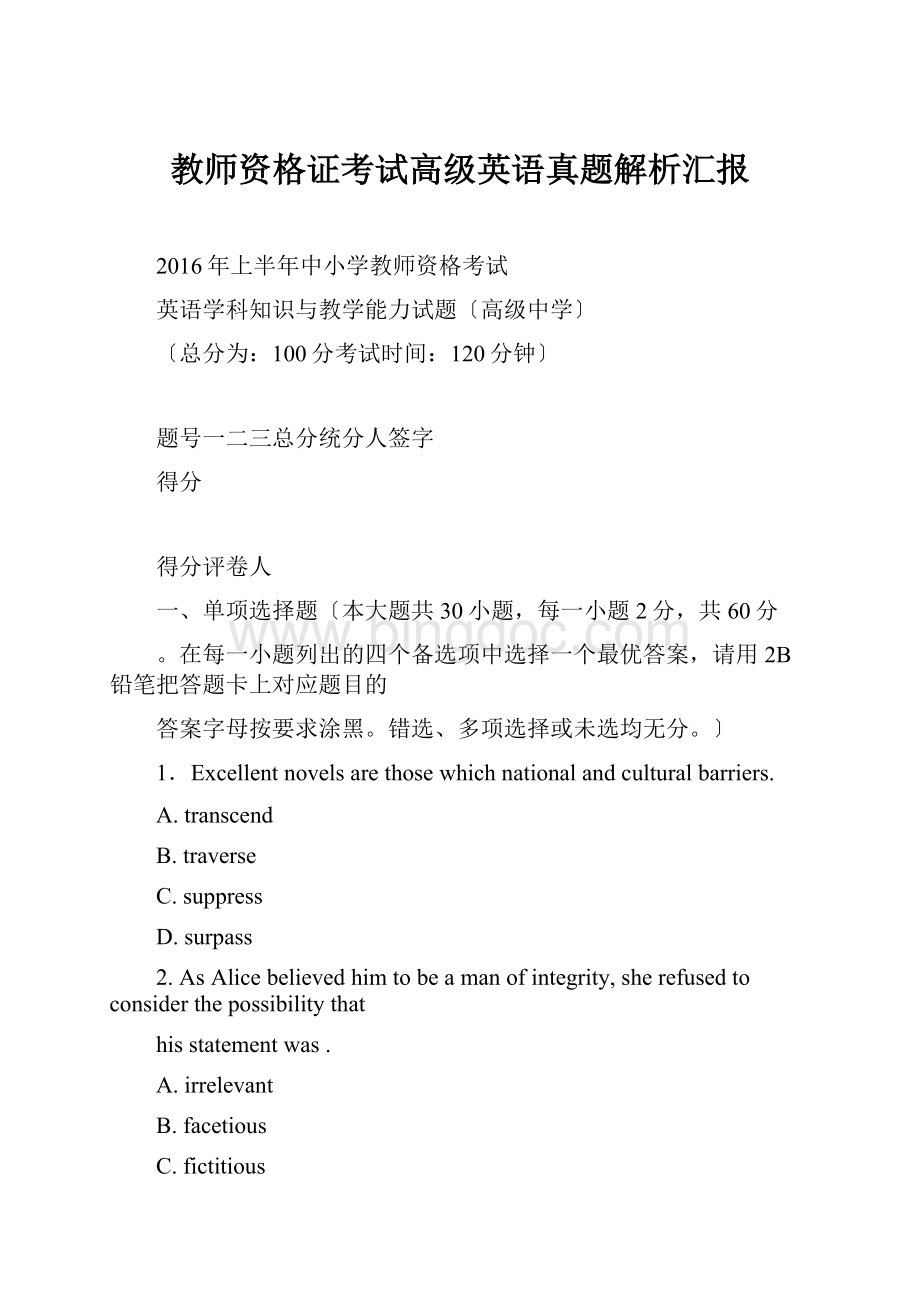教师资格证考试高级英语真题解析汇报Word格式.docx
《教师资格证考试高级英语真题解析汇报Word格式.docx》由会员分享,可在线阅读,更多相关《教师资格证考试高级英语真题解析汇报Word格式.docx(33页珍藏版)》请在冰点文库上搜索。

D.surpass
2.AsAlicebelievedhimtobeamanofintegrity,sherefusedtoconsiderthepossibilitythat
hisstatementwas.
A.irrelevant
B.facetious
C.fictitious
D.illogical
3.Thegirlsareafraidthatbeingfriendlytostrangerscouldbemisinterpretedbytheir
neighbours.
A.ever-present
B.ever-presented
C.ever-presenting
D.ever-presently
4.Hispresentationwillshowyoucanbeusedinothercontexts.
A.thatyouhaveobserved
B.thathowyouhaveobserved
C.howthatyouhaveobserved
D.howwhatyouhaveobserved
5.Manystudentsstarteachtermwithanawardcheck,butbythetimebooksarebought,foodispaidfor,andabitofsociallife,itlooksratheremaciated.
A.lives
B.lived
C.waslived
D.haslived
6.Whichofthefollowingiscorrectinitsuseofpunctuation?
A.Theteacherasked,“Whosaid,‘Givemelibertyorgivemedeath’?
〞
B.Theteacherasked,“Whosaid,‘Givemelibertyorgivemedeath?
’〞
C.Theteacherasked,“Whosaid‘Givemelibertyorgivemedeath’〞?
D.Theteacherasked,“Whosaid‘Givemelibertyorgivemedeath’?
7.ThepairofEnglishphonemesdifferintheplaceofarticulation.
A.//and//
B.//and//
C./d/and/z/
D./m/and/n/
8.Thereareconsonantclustersinthesentence“Brian,Iappreciatebeautifulscarfyoubroughtme.〞
A.two
B.three
C.four
D.five
9.Whensaying“It’snoisyoutside〞togetsomeonetoclosethewindow,thespeakerintends
toperforma(n).
A.directspeechact
B.locutionaryact
C.indirectspeechact
D.perlocutionaryact
10.ThataJapanesechildadoptedatbirthbyanAmericancouplewillgrowupspeaking
Englishindicatesofhumanlanguage.
A.duality
B.culturaltransmission
C.arbitrariness
D.cognitivecreativity
11.Fluentandappropriatelanguageuserequiresknowledgeofandthissuggests
thatweshouldteachlexicalchunksratherthansinglewords.
A.denotation
B.connotation
C.morphology
D.collocation
12.“Underliningallthepastformverbsinthedialogue〞isatypicalexercisefocusingon.
A.use
B.form
C.meaning
D.function
13.Whichofthefollowingactivitiesmaybemoreappropriatetohelpstudentspracticeanew
structureimmediatelyafterpresentationinclass?
A.Roleplay.
B.Groupdiscussion.
C.Patterndrill.
D.Writtenhomework.
14.Whenteachingstudentshowtogiveappropriateresponsestoacongratulationoran
apology,theteacherisprobablyteachingat.
A.lexicallevel
B.sentencelevel
C.grammaticallevel
D.:
discourselevel
15.Whichofthefollowingactivitiescanhelpdeveloptheskilloflisteningforgist?
A.ListenandfindoutwhereJimlives.
B.Listenanddecideonthebesttitleforthepassage.
C.Listenandunderlinethewordsthespeakerstresses.
D.Listentopairsofwordsandtelliftheyarethesame.
16.WhenanEFLteacheraskshisstudent“Howdoyouknowthattheauthorlikedtheplace
sincehedidnottellusexplicitly?
〞,he/sheishelpingstudentstoreachprehension.
17.Whichofthefollowingtypesofquestionsaremostlyusedforcheckingliteralprehension
ofthetest?
A.Displayquestions.
B.Rhetoricalquestions.
C.Evaluationquestions.
D.Referentialquestions.
18.Whichofthefollowingisatypicalfeatureofinformalwriting?
A.Awell-organizedstructureispreferred.
B.Shortandinpletesentencesaremon.
C.Technicaltermsanddefinitionsarerequired.
D.Awiderangeofvocabularyandstructuralpatternsareused.
19.Peer-editingduringclassisanimportantstepoftheapproachtoteachingwriting.
A.genre-based
B.content-based
C.process-Qriented
D.product-oriented
20.Portfolios,dailyreportsandspeechdeliveringaretypicalmeansof.
A.norm-referencedtest
B.criterion-referencedtest
C.summativeassessment
D.formativeassessment
请阅读Passage1,完成第21-25小题。
Passage1
WhentheViaductdeMillauopenedinthe.southofFrancein2004,thistallestbridgeinthe
worldwonworldwideaccolades.Germannewspapersdescribedhowit“floatedabovetheclouds〞
with“eleganceandlightness〞and“reathtaking〞beauty.InFrance,paperspraisedthe“immense〞
“concretegiant.〞WasitmerecoincidencethattheGermanssawbeautywheretheFrenchsawheft
andpower?
LeraBorodiskythinksnot.
Inaseriesofcleverexperimentsguidedbypointedquestions,Boroditskyisamassingevidence
that,yes,languageshapesthought.Theeffectispowerfulenough,shesays,that“theprivatemental
livesofspeakersofdifferentlanguagesmaydifferdramatically,〞notonlywhentheyarethinkingin
ordertospeak,“butinallmannerofcognitivetasks,〞includingbasicsensoryperception.“Evena
small’flukeofgrammar〞—thegenderofnouns-〞canhaveaneffectonhowpeoplethinkabout
thingsintheworld,〞shesays.
Asinthatbridge,inGerman,thenounforbridge,Brucke,isfeminine.InFrench,pontis
masculine.Germanspeakerssawprototypicallyfemalefeatures;
Frenchspeakers,masculineones.
Similarly,Germansdescribekeys(Schlussel)withwordssuchashard,heavy,jagged,andmetal,while
toSpaniardskeys(llaves)aregolden,intricate,little,andlovely.Guesswhichlanguageconstrueskey
asmasculineandwhichasfeminine?
Grammaticalgenderalsoshapeshowweconstrueabstractions.
In85percentofartisticdepictionsofdeathandvictory,forinstance,theideaisrepresentedbya
manifthenounismasculineandawomanifitisfeminine,saysBoroditsky.Germanstendtopaint
deathasmale,andRussianstendtopaintitasfemale.
Languageevenshapeswhatwesee.Peoplehaveabettermemoryforcolorsifdifferentshades
havedistinctnames—notEnglish’.lightblueanddarkblue,forinstance,butRussian’sgoluboy
and-stinly.Skepticsofthelanguage-shapes-thoughtclaimhavearguedthatthat’satrivialfinding,
showingonlythatpeoplerememberwhattheysawinbothavisualformandaverbalone,butnot
provin;
-thattheyactuallyseethehuesdifferently.Inaningeniousexperiment,however,Boroditsky
andcolleaguesshowedvolunteersthreecolorswatchesandaskedthemwhichofthebottomtwowas
thesameasthetopone.NativeRussianspeakerswerefasterthanEnglishspeakerswhenthecolorshaddistinctnames,suggestingthathavinganameforsomething’allowsyou-toperceiveitmore
sharply.Similarly,Koreanusesonewordfor“in〞whenoneobjectisinanothersnugly,anda
differentonewhenanobjectisinsomethingloosely.Sureenough,Koreanadultsarebetterthan
Englishspeakersatdistinguishingtightfitfromloosefit.
Sciencehasonlyscratchedthesurfaceofhowlanguageaffectsthought.InRussian,verbforms
indicatewhethertheactionwaspletedornot-asin“sheate[andfinished]thepizza.〞In
Turkish,verbsindicatewhethertheactionwasobservedormerelyrumored.Boroditskywouldlove
torunanexperimenttestingwhethernativeRussianspeakersarebetterthanothersatnoticingif
anactionispleted,andifTurkshaveaheightenedsensitivitytofactversushearsay.Similarly,
whileEnglishsays“shebrokethebowl〞evenifitsmashedaccidentally,SpanishandJapanese
describethesameeventmorelike“thebowlbrokeitself.〞“Whenweshowpeoplevideoofthe
sameevent,〞saysBoroditsky,“Englishspeakersrememberwhowastoblameeveninanaccident,
butSpanishandJapanesespeakersrememberitlesswellthantheydointentionalactions.Itraises
questionsaboutwhetherlanguageaffectsevensomethingasbasicashowweconstructourideasof
causality.〞
21.Whichofthefollowingisclosestinmeaningtotheunderlinedword.“accolades〞in
PARAGRAPHONE?
A.Praises.
B.Awards.
C.Support.
D.Gratitude.
22.WhatcanbeinferredfromPARAGRAPHTWO?
A.Languagedoesnotshapethoughtsinanysignificantway.
B.Therelationshipbetweenlanguageandthoughtisanage-oldissue.
C.Thelanguagewespeakdetermineshowwethinkandseetheworld.
D.Whetherlanguageshapesthoughtneedstobeempiricallysupported.
23.Whatistheroleoftheunderlinedpart“Asinthatbridge〞inPARAGRAPHTHREE?
A.Reflectingontopicsthatappealtotheauthorandreaders.
B.Introducingnewevidencetowhathasbeenconfirmedbefore.
C.Identifyingthekinds’ofquestions’supportedbytheexperiments.
D.Claimingthatspeakersofdifferentlanguagesdifferdramatically.
24.Whichofthefollowinghasnothingtodowiththerelationshipbetweenlanguageand
thought?
A.Peoplerememberwhattheysawbothvisuallyandverbally.
B.Language:
helpstoshapewhatandhowweperceive’theworld.
C.Grammarhasaneffectonhowpeoplethinkaboutthingsaroundus.
D.Sciencehasonlyscratchedthesurfaceofhowlanguageaffectsthought.
25.Whichofthefollowingbestrepresentstheauthor’sargumentinthepassage?
A.Thegenderofnounsaffectshowpeoplethinkaboutthingsintheworld.
B.GermansandFrenchmenthinkdifferentlyabouttheViaductdeMillau.
C.Languageshapesourthoughtsandaffectsourperceptionoftheworld.
D.Therearedifferentmeansofprovinghowlanguageshapesourthoughts.
请阅读Passage2,完成第26~30小题。
Passage2
WhenAmerican-bornactorMichaelPenawasayearold,hisparentsweredeported.They
hadillegallywalkedacrosstheU.S.borderfromMexicoandwhentheywerecaughtby
immigrationauthorities,theysent